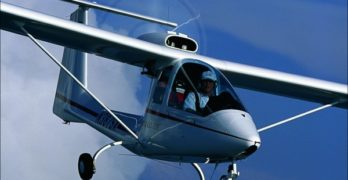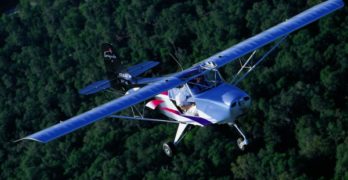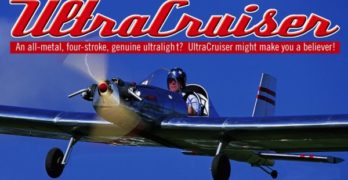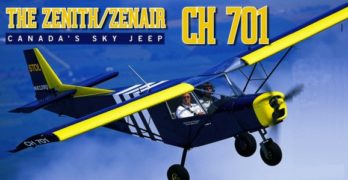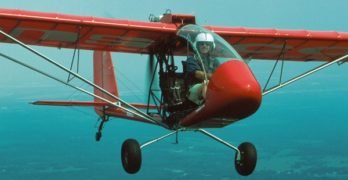Italy’s Sky Arrow makes its mark in the United States
Just as it is home to many fine sports cars, Italy is also home to some beautiful light aircraft-the Sky Arrow being one. The tandem two-seat airplane is designed and manufactured there by Iniziative Industriali Italiane S.p.A (III). Formerly known as Meteor, the company was started in 1947 and also manufactures gliders, airplanes, and remotely piloted vehicles.
Pacific Aerosystem Inc., of San Diego, California, is the United States importer of the Sky Arrow line. With more than 200 Sky Arrows flying worldwide and 25 in the United States, III is an experienced manufacturer and able to meet customer needs, reports Pacific Aerosystem, an important factor to consider when choosing an aircraft.
Currently, Pacific Aerosystem sells four ready-to-fly versions of the Sky Arrow. A kit version can be built under the experimental amateurbuilt rule. Powerplants and instrumentation delineate the models. An 80-hp Rotax 912 powers the 650 TCN and 560 T models.
Search Results for : electric
Not finding exactly what you expected? Try our advanced search option.
Select a manufacturer to go straight to all our content about that manufacturer.
Select an aircraft model to go straight to all our content about that model.
On An Escapade
Just Aircraft’s Excapade … certificated in England and ready for sport pilots!
Southwestern Idaho has long been a hub of aircraft activity. With ranches and towns settled in great distances, it’s not surprising that aviation, once an established mode of transportation, quickly became popular in that part of the west. It’s also not surprising, then, that the area has been a hub of aircraft building activity. Here’s the story of one aircraft that’s evolved from that heritage.
In 1983, a two-seat, steel tube and fabric aircraft called the Avid Flyer made its first appearance at EAA’s annual convention. Describing the new design in the October 1983 issue of EAA Sport Aviation, then editor Jack Cox wrote, “Dan Denney of Boise, Idaho, was the person with the idea from which sprang the Avid Flyer. He wanted ‘something between ultralights and homebuilts’|(and) Dan had a friend uniquely qualified to transform that (idea) into|an airplane, Dean Wilson.”
What Denney and Wilson demonstrated to the fly-in crowd that year might be called the forerunner of the pending light-sport aircraft category|even at a time when ultralights were still gaining their foothold.
Product Lines – March 1995
ST. PAUL, MINN. — Does hang gliding need to reach out for new enthusiasts? The question raises bothersome issues about declining and aging memberships, but is nonetheless a valid concern. ••• Industry leader, Wills Wing, is doing something about it by starting a new "division." They call it ProLine and its their vehicle to sell certain accessory items. Nothing new about this, you say? True, but Wills expects to do more than sell varios to their WW-brand customers. "It is our intention to use ProLine to develop products that can be marketed OUTSIDE the hang gliding industry", says a recent statement in their dealer newsletter. Naturally, they expect to raise their revenues but they further hope to increase hang gliding exposure to the public. They plan to advertise "in high circulation action sports pubications" once they have a "well developed product line." Each ProLine shipment will eventually have the USHGA color flier as well as the name of the closest WW dealer school.
Product Lines – September 1994
ST. PAUL, MINN. — Flyin’ high over Telluride. Early reports trumpeted spectacular flying at the mile-high site of the largest hang gliding event in the nation (world?). Reminded me of those altimeter ads from more than a decade ago when one advertiser teased pilots who had not yet equipped themselves. The ad featured a geeky-looking pilot saying, "I gained… er, …gobs of altitude." Remember? It was funny and meant to goad us into buying their wrist altimeter so we’d actually know the altitude we gained. Now, I compare that to modern reports of great flying days. No one wants to state any number of MSL feet above 17,999. Anyway, suffice it to say, Telluriders gained, er… gobs of altitude. Thanks to Gerry Charlebois. ••• Speaking of getting high, Moyes announced new prices for their gliders. Many businessmen would agree that when sales are good is the proper time to raise prices and indeed Moyes has said sales were never better.
Product Lines – January 1992
ST. PAUL, MINN — A new year of soaring begins and we can wonder what new records may fall (well, Larry?). What new designs will emerge? In the ’90s decade, UP and their TRX have enjoyed the limelight though sales still trail industry leaders Wills and PacAir. ••• Now UP offers an intermediate model using the successful TRX planform but with aluminum spars (it saves a few bucks). The XTR — once codenamed the TRX L — extends UP’s model line, cleverly employing the remarkable reception to the composite-framed competition model. The Utah-based builder is accepting orders while the glider completes HGMA certification. Selected dealers have flown the XTR and are reportedly excited. ••• Near the end of ’91, National Champ’ Tony Barton and aerobatic guru John Heiney returned from an eastern road tour promoting UP. A western tour is planned next. Contact the factory to be included in these plans.
Product Lines – November 1990
ST. PAUL, MINN — In announcing minor refinements on the Sensor E model, Seedwings begins to reveal their accord with the Austrian distributor now representing the brand in Europe. ||| First, the E model has control bar hardware which permits the glider to be laid down flat without disassembly of the wings. This has long been a requirement of the European pilot. Next, the Sensor has a speedbar, which they’ve subjected to 1,000 pounds without seeing deformation. It has only a 2.5 inch offset, reducing flex and allowing better in-bag storage. ||| Bob Trampenau’s design will now use streamlined down tubes offered by Finsterwalder, one of Europe’s up and coming manufacturers (who recently acquired the Charly company, a big manufacturer of safety and accessory products in Germany). Seedwings has enabled the airfoil downtubes to fit all models of the Sensor line. ||| While many pilots are attracted to the airfoil downtubes, some pilots raise a question.
Product Lines – July 1990
ST PAUL, MINN — Several recent calls and letters referred to rigid wings presented here. Are we experiencing an upsurge of real interest? Or just another bubble of enthusiasm that will burst with the announcement of some new hotter-than-ever rag wing? No one knows. ||| Meanwhile in response to several inquiries, you can contact the Owens Composites Swift people at 10000 Trumbull SE, Albuquerque NM 87123. Their February Swift News announced work on an article for Hang Gliding. Watch for it. ||| Two other projects bear mention here: Advanced’s Sierra and the Cloud Dancer ||| The ultralight company Advanced Aviation, is flying their second prototype Sierra ultralight sailplane (42 foot span and greatly cleaned up). I saw #2 flown by towplane designer Bobby Bailey — who is also the principal designer of this bird — and I flew the #1 machine some months ago. The original prototype had promise which the successor significantly reveals.
All-metal, Four-stroke, Genuine Ultralight
The new light-sport aircraft (LSA) category will soon be a reality. While a best guess is that FAA’s newest rules could be announced at EAA AirVenture Oshkosh later this month, it may happen later in the year. Whenever it happens, and like many others watching closely, I hope this new concept arrives swiftly with its promise of interesting aircraft at affordable prices.
As important as LSA may be, however, the proposed new the rule doesn’t affect other enjoyable flying machines. Aircraft built under the amateur-built (51-percent) rule will continue to be a major factor. Many EAA members are building under this rule, and these aircraft will continue to offer wide choices, performance beyond that of many general aviation aircraft, and the pride of craftsmanship. LSA also leaves room for Part 103 ultralights to continue and grow. While some industry leaders see little demand for single-seat aircraft powered by small engines-and it is true that they do not make up a majority of machines-neither, however, will they disappear.
Canada’s Sky Jeep
Pilots will go to great lengths to fly airplanes they like. I went to the Czech Republic to fly the CH 701. That’ s a long way, and I did like the airplane. The experience tells a story of light-sport aircraft development that may become increasingly common.
Like most light plane pilots, I’ve long been familiar with the designs of Swiss-born engineer Chris Heintz. His many aircraft models have put some 2,000 builders in the air. The low-wing, Piper Cherokee-like CH 601 is far and away the most popular air plane he’s designed, with it representing more than 60 percent of all Zenith models sold. Yet, perhaps the most distinctive-looking design he’s offered is the short takeoff and landing (STOL) capable CH 701, the subject of our discussion this month. Now the world grows smaller with Heintz’s Canadian designs being manufactured in the Czech Republic and freighted to the United States for fun in the sky.
Ultralight Trainer from RANS
“RANS is back!”
said many ultralight enthusiasts when the company offered their production version of the S-17 Stinger in September, 1999. Now the Kansas company has reaffirmed their commitment to the ultralight community by offering an enlarged S-17 with an added, tandem seat. Welcome to the S-18 Stinger II.
Of course this isn’t the first ultralight trainer from RANS. They continue to sell their S-12XL Airaile 2-seater. Others may observe that the S-6 Coyote 2-place can be built to operate within the limits of the Part 103 training exemption.
But when RANS first talked about their single-place Stinger – the prototype model that was never marketed – the company had been going in another direction. In those days the apparent darling of the company was the S-16 Shekari that is more accurately described as competition for Van’s RV series than as an ultralight. RANS president Randy Schlitter was able to see that ultralights didn’t simply grow up and become “light aircraft.” And, since Schlitter wants a share of the ultralight community, the S-17 single-place Stinger was his 1999 entry to entice ultralight flyers to the RANS brand name.
- « Previous Page
- 1
- …
- 56
- 57
- 58
- 59
- 60
- …
- 67
- Next Page »


